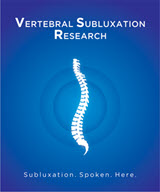Groundbreaking Research on Vertebral Subluxation Epidemiology Completed

Christie Kwon DC, MS, MPH, Executive Director of the Foundation for Vertebral Subluxation, is the lead author and investigator on a recently completed study to estimate the prevalence of vertebral subluxation in the population and to explore the public health implications of subluxation using a sample of individuals presenting for chiropractic care.
The study, titled: Secondary Analysis of a Dataset to Estimate the Prevalence of Vertebral Subluxation and its Implications for Health Promotion and Prevention, analyzed a total of 1,851 patient records from 7 chiropractic clinics in 4 states. The study found that the overall prevalence of vertebral subluxation was 79%.
Kwon was joined by her co-authors on the project - Jose Binongo Ph.D from the Department of Biostatistics at Emory University's Rollins School of Public Health and Matthew McCoy DC, MPH, Vice President of the Foundation for Vertebral Subluxation.
The Foundation for Vertebral Subluxation has been working on studies involving the epidemiology of vertebral subluxation for several years now and those efforts are beginning to bear fruit.
Foundation President Christopher Kent DC, JD is additionally working on an epidemiological study on the prevalence of vertebral subluxation in several hundred patients using MRI.
Foundation Board member Curtis Fedorchuk DC is also in the final stages of data analysis and manuscript preparation on another epidemiological study of subluxation prevalence involving a large dataset along with co-investigators Doug Lightstone DC, Jose Binongo Ph.D, Christopher Kent DC, JD and Matthew McCoy DC, MPH.
All too often, chiropractic is criticized as an “unscientific” discipline, lacking empirical research to validate the assertion that vertebral subluxations have an adverse effect on the human nervous system, on general health and well-being and by extension, society as a whole.
It is the extension to society as a whole where subluxation has been theorized to have its most detrimental effects. If this is true, then this is also where its elucidation holds the greatest promise for influencing and affecting communal expression.
The systematic study of the epidemiology and global burden of vertebral subluxation should be carried out by individuals and groups with a worldview towards chiropractic that is consistent with the theory that subluxations pose a hindrance to the fullest expression of life.
The results of this type of research can then be used to drive policy, not only in health care, but in education and other sociocultural arenas.
It is a well-entrenched belief within the community of chiropractors who practice the clinical science and art of locating analyzing and correcting vertebral subluxations that vertebral subluxations are in and of themselves a detriment to the fullest expression of life and as a result are a significant public health threat. This threat includes the widespread belief among segments of the chiropractic profession that vertebral subluxations lead to increased morbidity and mortality and that it represents a serious burden because it affects a large proportion of the world’s population. Indeed, some go so far to suggest that everyone is susceptible beginning at an early age. Additionally, it is a long standing philosophical tenet of the profession that vertebral subluxations develop as a failure of the body to adapt to physical, chemical and emotional challenges.
Unfortunately, the chiropractic profession has not systematically studied the epidemiology of vertebral subluxation by collecting and analyzing the necessary statistical data. While some attempts have been made in chiropractic as well as osteopathy to determine the prevalence of vertebral subluxation and somatic dysfunction, a great deal more needs to be done. Minimally, the chiropractic profession has not studied how many people have vertebral subluxation, who gets specific types of subluxations and what factors (such as environment, occupation, family patterns, and personal habits, such as smoking and diet) play in the development of vertebral subluxation.
The series of epidemiological studies being carried out by the Foundation are a huge step forward towards answering these fundamental questions.
Kwon's study included evaluation of patient demographic data including age, gender, and past health history characteristics. In addition to estimating overall prevalence of vertebral subluxation, age and gender-stratified estimates in the different clinics were calculated to allow for potential variations.
The dataset was provided by EPIC Chiropractic Clinics headed by its CEO Stan Pierce Jr., DC, B.C.A.O. EPIC Clinics are upper cervical chiropractors who utilize objective assessments to characterize the biomechanical and neurological components of vertebral subluxation.
With nearly 2000 subjects in the sample from 7 chiropractic clinics in 4 states, the study is one of the largest of any kind in the history of chiropractic. The age range was from 18-91 years with subjects reporting various spinal and extremity pain, numbness, tingling, headaches, ear, nose, and throat-related issues, visceral symptoms, mental health concerns, neurocognitive issues, and concerns about general health as well as overall wellness as their reasons for seeking chiropractic care.
The authors concluded that there was broad geographic distribution and that the results of the study suggest a high rate of prevalence of vertebral subluxation in a sample of individuals who sought chiropractic care. The authors call for further investigation into the epidemiology of vertebral subluxation and its role in health promotion and prevention.

Blogs
- The Chiropractic Cartel: A Look Back at Bias in Accreditation and its Imact on Today's Profession
- Inside Montana's Chiropractic Monopoly: ACA & MCA's Brazen Board Takeover
- Concerns Grow About Control of the NY State Chiropractic Board by the ACA - Use of X-ray in NY Under Threat
- Reproductive Health Information and Chiropractic Care: Navigating New Privacy Regulations
- Navigating Substance Use Disorder (SUD) Consent: What Chiropractors Need to Know













